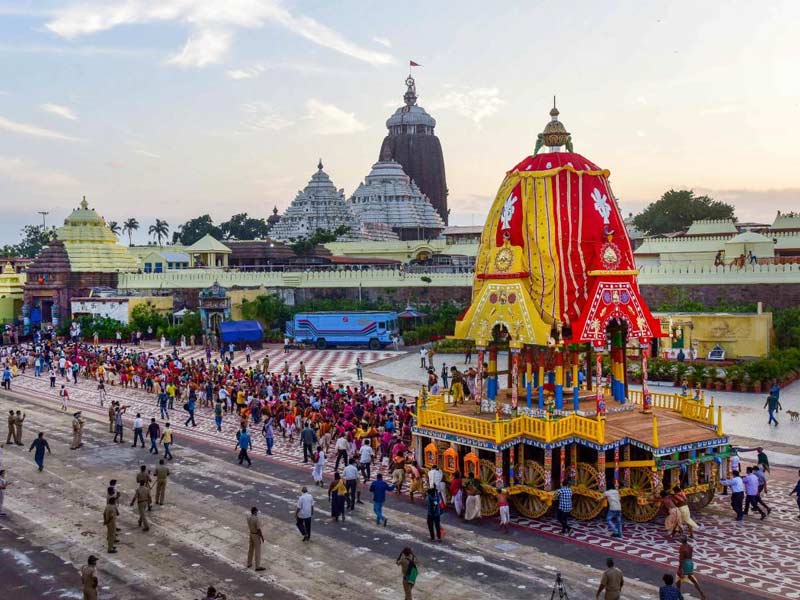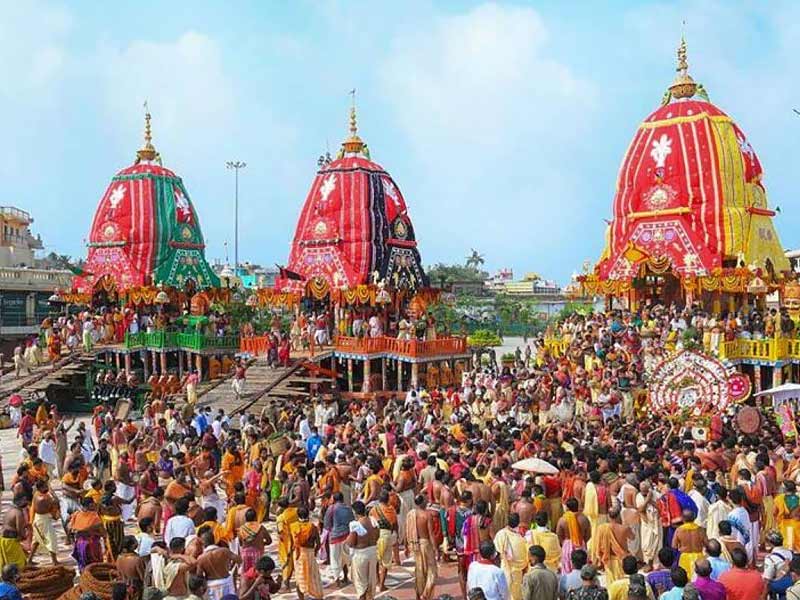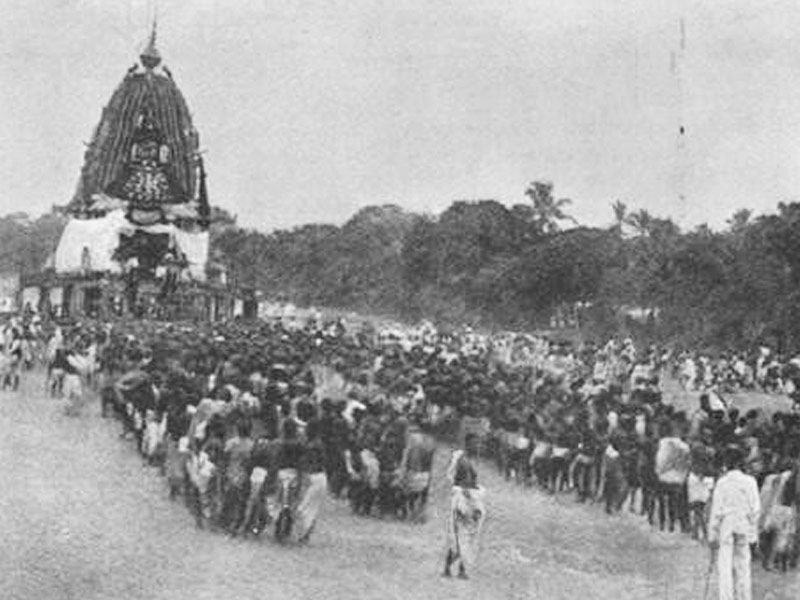Rath Yatra, also known as Ratha Jatra or Chariot festival, is a Hindu event performed in Odisha for Jagannath and other Hindu deities. During the annual public procession of Lord Jagannath in Puri, thousands of devotees flock to the city to view Lord Jagganath in a chariot. His picture, along with the other two connected deities, is ceremoniously removed from the inner sanctum of Jagannath Puri’s main temple. They are loaded into a chariot, which is then drawn by many volunteers to the Gundicha Temple, which is almost 3 kilometers away. Similar processions are held in Jagannath temples worldwide to coincide with the Ratha Yatra celebration in Puri.
Rath Yatra joins together two Sanskrit words: Ratha, meaning chariot or yatra, meaning pilgrimage or expedition.
Phonetic counterparts, such as rath and yatra, are used in other Indian languages, such as Odia. The celebration is also known as rath jatra or chariot festival.
The phrase first appears in medieval Indian writings such as the Puranas, which reference the Rath Jatra of Surya (Sun deity), Devi (Mother goddess), and Vishnu. Rath Jatra usually refers to deities’ procession (travel), humans disguised as deities, religious saints, and political leaders. These chariot excursions are marked by extravagant festivities in which persons or deities emerge from a temple, escorted by members of the public who accompany them across the Ksetra (area, streets) to another temple, the river, or the sea. Returning to the temple’s sacrosanctum is sometimes part of the festivities.

Considered one of the oldest Rath Yatra in India and around the world, the Rath Yatra in Puri is an unforgettable one. This yearly celebration is held on Ashadha Shukla Paksha Dwitiya (the second day in the bright fortnight of Ashadha month). The importance of the location is Jagannath Temple, which was created and safeguarded by Kabir Saheb Ji’s favor. Since the Treta Yuga, Ocean has wanted to exact vengeance on Shri Krishna. Kabir Ji preserved the temple since he had promised Kaal that he would keep it from being demolished. This temple has been standing since then.
The three deities pause for a bit near the Mausi Maa Temple (Aunt’s home) on their way back from the Gundicha Temple and enjoy an offering of the Poda Pitha, a particular sort of pancake said to be the Lord’s favorite. The deities return to their dwelling after a seven-day visit.
The Chariots

Every year, the three chariots of Jagannath, Balabhadra, and Subhadra are reconstructed with wood from certain trees like phassi, dhausa, and others. They are traditionally transported from the ex-princely kingdom of Dasapalla by a team of carpenters with ancestral rights and privileges. The logs are historically used as rafts in the Mahanadi River. These are collected around Puri and then driven to the destination. On the Bada Danda, the Grand Avenue, three chariots are adorned according to a unique plan that has been followed for generations.
The wooden chariot is built of a specific type of Neem tree wood, disassembled, and used as fuel in the temple kitchen to serve prasad. Lord Jagannath’s Rath Nandighosha stands around 44 feet tall, has wheels, and has strong colors such as red and yellow. Balbhadra’s chariot, Taladhwaja, stands 43 feet tall and has 14 wheels. Subhadra’s crimson and black chariot has 12 wheels and is 42 feet tall. The chariot canopies are constructed of about 1200 meters of fabric. The canopies are made by a crew of 15 tailors. The chariots are lined up in front of the temple at the Sinhadwara or Lion’s Gate, also known as the temple’s eastern entrance.
Nine Parsva devatas, painted wooden figures symbolizing various deities on the chariots’ flanks, surround each chariot. There is a charioteer (Sarathi) and four horses in each chariot.
The Rituals

To mark the commencement of the yatra, the king dresses as a sweeper. He sweeps the road with a golden broom and water, fortifying it with sandalwood paste. The Chera Pahara ceremony is what it’s called. Onlookers claim that despite the devotees’ best efforts, the Rath does not move. Rath begins to move only after a few hours of celestial efforts and the singing of ‘Dahuka boli.’
Lord Jagannath and his siblings accept the challenge. After a stay at the Gudischa temple, where they were offered Poda Pitha, they halted on their journey back to their own house.
For one week before the celebration, the main door of the Puri Jagannath Temple is kept locked. After having his yearly bath, the Lord is said to have had a severe fever. The sanctum sanctorum is closed to the public at this time. The Lord proceeds to his maternal aunt’s residence, known as the Rath Yatra, once his period of rest is over.
Also Read, The Beauty of Unique Sikkim Festivals
The preparations begin with the construction of new chariots on the auspicious day of the Akshay Tritiya. Charioteers, horses, temple kalasas, and Parsha devatas, on the other hand, are only produced during the Navakalebara festival. After the Deul Purohit performs the Ratha Pratistha puja on Sri Gundicha day, a procession begins from the Jagannath temple sanctuary to the rathas, a rite known as Pahandi.

Sudarsana is carried first to Subhadra’s Ratha, followed by Balabhadra in a procession. The Daitapatis and other sevakas next take Subhadra to her ratha. The Mahajan Sevakas then carry Madanmohan to the rathas, and the Chhera Pahamra is performed by Gajapati Maharaja (King of Puri). The king is dressed as a sweeper and undertakes the chore of sweeping (chhera) and cleaning (pahamra) all around the rathas with a gold-handled broom while spraying sandalwood powder and water. Lastly, Jagannath is taken to his Ratha by the Daitapatis and other sevakas.
Following King Anangabhima III’s declaration of Sri Jagannatha as Odisha’s state god in 1230 CE, the kings became representational rulers (mudarasta) under the deity’s supreme over-lordship. Despite monarchy being obsolete, the big Chhera Pahamra ritual is still the most significant “royal duty.” It is known as the Gajapati Maharaja Seva, making the “Maharaja” of Puri a vital component of the celebration even now. On the first day of the Rath Yatra, and again on the end day of the yatra, when the deities are returned to the Jagannath Mandir, Chhera Pahamra is performed.
The rathas begin their trip after Chhera Pahamra. They are dragged by many worshippers to the Gundicha Temple, which is about 3 kilometers distant, where the deities dwell for nine days. In bahuda yatra, the deities are returned to Jagannath Mandir in their respective rathas on the last day (Ulta Rath yatra).
Moksha Yatra
Surprisingly, this Rath Yatra is also seen as a life journey done to attain Moksha. The ratha is a symbolical portrayal of a body in the Katha Upanishad (1:3:3:4). The yatra is the journey traveled in every life. Every birth, the body (shareera) embarks on a yatra (journey) to achieve its eventual goal (Moksha); this yatra is called Rath Yatra.




























